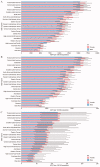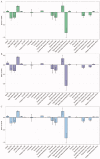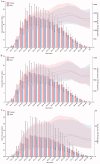Global, regional and national burden of gastroesophageal reflux disease, 1990-2019: update from the GBD 2019 study
- PMID: 35579516
- PMCID: PMC9122392
- DOI: 10.1080/07853890.2022.2074535
Global, regional and national burden of gastroesophageal reflux disease, 1990-2019: update from the GBD 2019 study
Abstract
Background: Because trends in the epidemiology and burden of gastroesophageal reflux disease (GERD) are changing, reinvestigating the geographical differences and trend changes is essential. Here we evaluated the latest epidemiologic patterns and trends for GERD, using data from Global Burden of Diseases, Injuries, and Risk Factors Study (GBD) 2019.
Methods: Annual case numbers, age-standardized rates of prevalence, incidence, and years of life lived with disability (YLDs), and their estimated annual percentage changes (EAPCs) for GERD between 1990 and 2019 were derived from the GBD 2019 study. Association between GERD burden and socio-demographic index (SDI) was also investigated.
Results: In 2019, there were 783.95 million cases of GERD globally. Between 1990 and 2019, the total number of prevalent cases, incident cases, and YLDs increased by 77.53%, 74.79%, and 77.19%, respectively. The global age-standardized incidence rate (ASIR) and age-standardized YLD rate (ASYR) increased during this period (EAPC = 0.06 and 0.05, respectively). Tropical Latin America and East Asia had the highest and lowest age-standardiZed prevalence rate (ASPR), ASIR, and ASYR in 2019, respectively. From 1990 to 2019, prevalent cases, incident cases, YLDs, and their corresponding age-standardized rates of GERD were higher in females than males in all years. Higher SDI was associated with lower ASPR, ASIR, and ASYR of GERD in 2019.
Conclusions: GERD will continue to be a major public health burden due to increasing numbers of prevalent cases, incident cases, and YLDs. In order to tackle this troublesome disease, it is crucial to understand the changes in both global and regional trends in epidemiology and the burden for policymakers and other stakeholders. Key messagesThis is the most updated estimate on GERD epidemiology globally, including 204 countries, some of which were not assessed before.The overall burden of GERD continued to worsen with the prevalent cases increasing by 77.53% from 441.57 million in 1990 to 783.95 million in 2019.GERD is likely to remain a common reason for consultation in primary care, and our data may allow for health service provision planning.
Keywords: Gastroesophageal reflux disease; epidemiology; global burden of disease; prevalence.
Conflict of interest statement
The authors declare no conflict of interest.
Figures





References
-
- Maret-Ouda J, Markar SR, Lagergren J.. Gastroesophageal reflux disease: a review. JAMA. 2020;324(24)–1384. - PubMed
-
- Fass R, Boeckxstaens GE, El-Serag H, et al. . Gastro-oesophageal reflux disease. Nat Rev Dis Primers. 2021;7(1):1372. - PubMed
-
- Katzka DA, Kahrilas PJ.. Advances in the diagnosis and management of gastroesophageal reflux disease. BMJ. 2020;371:m3786. - PubMed
Publication types
MeSH terms
LinkOut - more resources
Full Text Sources
Other Literature Sources
Medical
